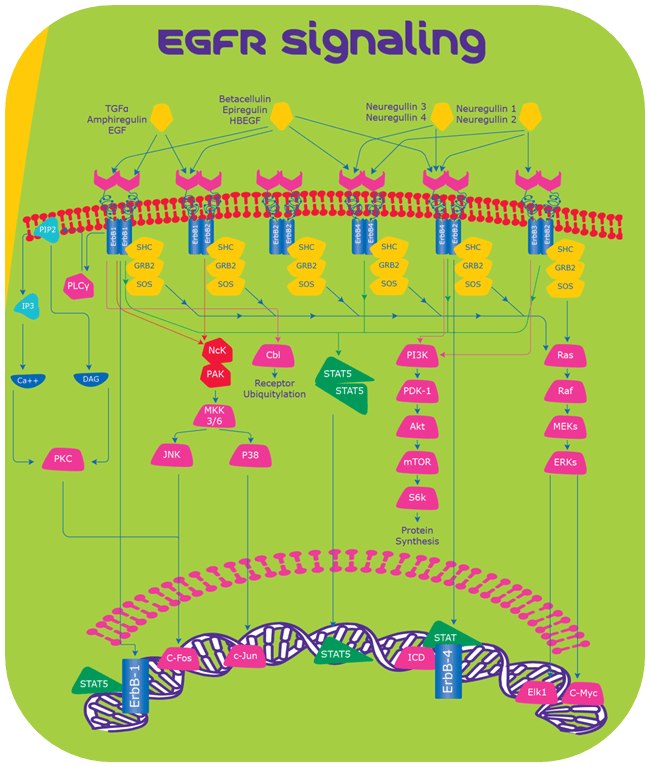Epidermal Growth Factor Receptor (EGFR) Signaling
Background
Epidermal Growth Factor Receptors (EGFR) and Ligands
Receptor Activation
EGFR Signaling
Ras/Raf Signaling Cascade
Phosphatidylinositol 3-kinase/Akt Signaling Cascade
Signal Transducers and Activators of Transcription (STAT) Pathway
Phospholipase Cγ Signaling
Nck/PAK Signaling Cascade
Cbl Mediated Endocytosis
EGFR Translocation into Nucleus
EGFRs in Development & Disease
Conclusion
Background
Epidermal growth factor receptor (EGFR) is the first discovered and prototypical member of receptor tyrosine kinase family (RTK) of receptors. It is activated by various ligands in extracellular milieu and transmits the cellular response to mediate various cellular activities, including cell proliferation, cell survival, growth, and development. EGFR is expressed in many organs and aberrant expression is implicated in various cancers. This review highlights various signaling components of EGFR pathway and their signal transduction pathways.
Epidermal Growth Factor Receptors (EGFR) and Ligands
The ErbB family comprises of four receptors, which include EGFR (ErbB-1/HER1), ErbB-2 (Neu, HER2), ErbB-3 (HER3), and ErbB-4 (HER4). This receptor tyrosine kinase family (RTK) of proteins has an extracellular ligand-binding domain, hydrophobic transmembrane domain, and a cytoplasmic tyrosine kinase domain (Table 1). ErbB receptors are activated by growth factors of EGF-family characterized by three disulphide-bonds that confer binding specificity. Additional structural motifs include immunoglobulin-like domains, heparin-binding sites and glycosylation sites1,2.
Receptor Activation
Receptor activation is triggered by the cascade of events on cell membrane.
- Ligand binding: Each ligand binds to the extracellular domain of cognate ErbB receptors
- Receptor dimerization: Ligand binding induces the formation of receptor homo or hetero dimers3.
- Activation of kinase domain: Autophosphorylation of key tyrosine residues within carboxy terminal tail activates the receptor and acts as docking sites for proteins with Src homology 2 (SH2) and phosphotyrosine binding domain (PTB) to trigger cellular signaling3,4.

Figure 1.EGFR Signaling
EGFR Signaling
Ras/Raf Signaling Cascade
Receptors: Dimerization of any two ErbB receptors
Key Functions: Cell survival and cell proliferation5
After receptor activation, the complex formed by Grb2 and Sos binds directly or through association of adapter protein Shc, to specific tyrosine residues on the receptor6,7. This leads to conformational change in Sos, which can recruit and activate Ras-GDP. Ras-GDP activates Raf-1, which further activates extracellular regulated kinases 1 and 2 (ERK1 and ERK2) mediated through mitogen-activated protein kinases (MAPK)8,9. Activated kinases eventually move into the nucleus to phosphorylate specific transcription factors like Elk1 and C-myc to induce cell proliferation.
Phosphatidylinositol 3-kinase/Akt Signaling Cascade
Receptors: Dimerization of ErbB2 with either ErbB4 or ErbB3
Key Functions: Cell growth, apoptosis resistance, cell invasion and migration10
Phosphatidylinositol comprises of p85 and p110 sub units that dock to the ErbB receptor to generate secondary messenger phosphatidylinositol 3,4,5-triphosphate, that further activates serine/threonine kinase AKT. Upon activation, AKT phosphorylates mTOR and subsequently S6K which mediates protein synthesis10.
Signal Transducers and Activators of Transcription (STAT) Pathway
Receptors: ErbB
Key Functions: Tumor progression, oncogenesis and angiogenesis11
STAT proteins docks to the phosphotyrosine residues of ErbB receptors via Src homology 2 domains and up on dimerization, translocate into the nucleus to promote the expression of specific target genes like Myc, Nos2, p21 and cytokines12.
Phospholipase Cγ Signaling
Receptors: ErbB1
Key Functions: Regulation of ion channels, cell migration, calcium-mediated signaling13
Phospholipase Cγ interacts with ErbB1 and hydrolyses phosphatidylinositol 4,5-diphosphate (PIP2) to generate inositol 1,3,5-triphosphate (IP3) and 1,2 diacylglycerol (DAG). IP3 increases intracellular calcium levels and DAG mediates activation of protein kinase C (PKC)13. Activated PKC in turn activates MAPK and c-Jun NH2-terminal kinase14.
Nck/PAK Signaling Cascade
Receptors: ErbB1
Key Functions: Cell survival and cell migration15
Nck is an adaptor protein containing SH2 domain that binds to EGF receptor and triggers downstream signaling. Nck activates PAK1 (p21/CDC42/Rac1-Activated Kinase-1) binding through SH3 domain. Activated PAK1 in turn activates JNKs (c-Jun Kinases) mediated by MEKK1 (MAP/ERK Kinase Kinase-1) and MKK4/7 (MAP Kinase Kinase-4/7), respectively. JNK translocates to the nucleus and phosphorylates transcription factors like c-Fos and c-Jun16.
Cbl Mediated Endocytosis
Receptors: ErbB1
Key Functions: Endocytosis
Following ligand binding, Cbl is a substrate that binds to the EGF receptors through SH2 domains or through GRB2 adaptor protein and triggers lysosomal degradation of receptors17.
EGFR Translocation into Nucleus
EGF Receptors have an ability to escape lysosomal degradation and translocate into the nucleus to mediate biological functions. In the nucleus, these receptors promote transcription of cell survival genes like Cyclin D1 gene and also act as cofactors for STAT and E2F1 transcription factors18. Nuclear localization of EGFR is implicated in disease severity by conferring resistance to growth inhibitory effects of anti-cancer mAbs19.
Our most popular, high-quality EGF proteins for your research use
EGFRs in Development and Disease
EGF receptors and their ligands are important for development of various organs; EGFR knockout models show embryonic lethality and defective tissues/organs. However, mutations in ErbB ligands do not show any lethal phenotype, because the complimentary pathways of other ligands compensate the abrogated signals of mutated ErbB ligand.20-25 EGFR are abnormally activated or expressed in many diseases. Specifically, their role in cancer progression is well investigated (Table 2).
Conclusion
EGFR signaling has pleiotropic functions in development and regulates various physiological functions. The aberrant expression of EGF receptors has been increasingly implicated in various disorders. More research is yet to clearly uncover the role of EGFR signaling in development of various organs, including brain, heart, skin, kidneys, mammary glands, and lungs. Efforts to identify novel drugs with high efficacy, sustained drug activity and less cross reactivity to combat drug-resistant cancer conditions continue to pique lot of research interest.
Para seguir leyendo, inicie sesión o cree una cuenta.
¿No tiene una cuenta?